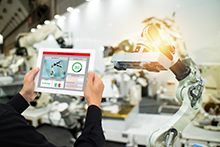 Product service and service lifecycle management (SLM) are undergoing significant changes. Companies are leveraging the advent of smart, connected products, the Internet of Things (IoT), and the Industrial Internet of Things (IIoT) to capture and manage more information about the in-service use and status of products and systems. This information is enabling them to provide better service to their customers and create new business models in which service rather than the product is the focus, e.g., “power by the hour” made famous by GE for their jet engines.
Product service and service lifecycle management (SLM) are undergoing significant changes. Companies are leveraging the advent of smart, connected products, the Internet of Things (IoT), and the Industrial Internet of Things (IIoT) to capture and manage more information about the in-service use and status of products and systems. This information is enabling them to provide better service to their customers and create new business models in which service rather than the product is the focus, e.g., “power by the hour” made famous by GE for their jet engines.
Historically, with some exceptions, product service has been reactive, primarily repairing products when there is a problem or failure. Products were standalone entities and service personnel used standard repair kits and static, often dated, technical service manuals. But products are becoming increasingly complex, incorporating more electronics and software to the point that differentiation in product models and capabilities is primarily driven by software, not mechanical capabilities. Products are moving from standalone items to complex electro-mechanical systems that are part of systems of systems. These smart, connected products provide real-time data on operational performance, duty cycle use, errors and failures, and other key information that can be used to monitor in-use performance and failures as well as provide the data used to perform analytics on them. Additionally, the IoT and IIoT enable systems to directly communicate with one another as well as provide input data to monitoring and analytics systems.
Initiatives like Industrie 4.0 are taking advantage of IoT/IIoT and the interaction and availability of information to change the way service is being performed, enabling companies to create new business models built around service. Service personnel now can interactively and remotely access PLM-managed product information and service systems to use service technical documentation in the context of the configuration of the product or system in service and the tasks to be performed.
Analytics on the data gathered from smart, instrumented, and connected products and systems enable service systems and personnel to maintain equipment at optimum operational levels (including dynamically adjusting operational parameters) and to proactively determine when and what type of maintenance should be performed. Additionally, this connectivity is enabling more direct feedback from service systems and products in the field to PLM and the design and engineering organizations—enabling them to correct current product design and create new products that operate better. PLM processes are now incorporating service information and results as part of the overall development process and better support design for serviceability.
Whether it is a production machine in a factory, an appliance in a home, an aircraft engine in flight, or a truck hauling goods on a highway, these “products” are sending real-time information to service systems that are analyzing their performance. When the aircraft lands, maintenance personnel already know what work needs to be done and have the information and service kits needed to do the work. The truck driver will receive a message telling him or her the location of a service facility that has the needed parts and equipment to do the service and has been notified to expect them.
Smart, connected products, interacting over the Internet are dramatically changing the products and systems we use and the way in which service is delivered. These new capabilities help ensure products and systems are online, working at optimum capability, and are serviced fully and correctly with the first service call. As SLM becomes more embedded within the overall PLM environment, the integration of in-service information and its analyses back into the design, engineering, and manufacturing environment and processes will enable companies to develop and produce higher quality innovative products that better meet customer needs.
Let me know what you think!
Ken
Learn more about this topic at CIMdata’s up-coming PLM Market & Industry Forum.
The bottom line
- Products are moving from standalone items to complex electro-mechanical systems that are part of systems of systems.
- Smart, connected products provide real-time data on operational performance, duty cycle use, errors and failures, and other key information.
- The IoT and IIoT enable products and systems to directly communicate with one another, provide data to monitoring and analytics systems, and feed service-related information back into PLM development and manufacturing processes.
- This interaction and availability of information is changing the way service is being performed and enabling new business models built around service.


Be the first to post a comment.